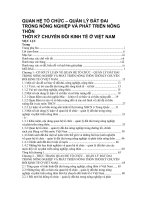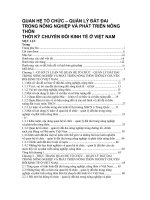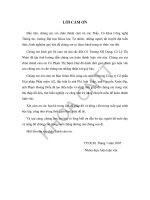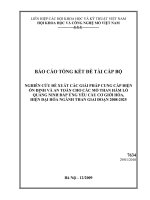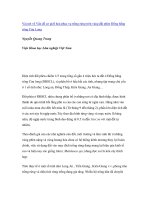vegettable1 Cơ giới hóa hiện đại trong nông nghiệp
Bạn đang xem bản rút gọn của tài liệu. Xem và tải ngay bản đầy đủ của tài liệu tại đây (5.24 MB, 37 trang )
VEGETABLES POSTHARVEST
Simple techniques for increased income and market
Second Edition
Antonio L. Acedo Jr.
Katinka Weinberger
June 2010
AVRDC – The World Vegetable Center
GTZ – Regional Economic Development Program
Published by
AVRDC-The World Vegetable Center and
GTZ-Regional Economic Development Program
AVRDC-The World Vegetable Center
is the leading international nonprofit organization
committed to alleviating poverty and malnutrition in the developing world through the increased
production and consumption of safe vegetables.
Contact: AVRDC - The World Vegetable Center
P.O. Box 42, Shanhua, Tainan 74199
TAIWAN
Tel: +886 6 583 7801
Fax: +886 6 583 0009
Email:
Web: www.avrdc.org
GTZ-Regional Economic Development (RED) Program
is a Cambodian development
program funded by the German Federal Ministry for Economic Cooperation and Development,
aimed at promoting rural economic dev elopment, including the competitiveness of local
vegetables and fruits, through a market driven approach to improving the participation of rural
poor in the value-added created on Siem Reap’s markets and building capacity to solve
bottlenecks from production to consumption.
Contact: GTZ-RED Green Belt
P.O. Box 93221, G.P.O. 17000, Siem Reap
CAMBODIA
Tel.: +855 63 761 931, +855 12 876 890
E-mail: ,
Second Edition, June 2010
© 2010 AVRDC - The World Vegetable Center and GTZ-Regional Economic Development
Program
Suggested citation
Acedo AL Jr., Weinberger K. 2010. Vegetables postharvest: Simple techniques for increased
income and market. AVRDC – The World Vegetable Center, Taiwan and GTZ-Regional
Economic Development Program, Cambodia. 37 p.
2
Contents
Page
Importance of vegetables postharvest
Postharvest loss
Reducing postharvest loss
Knowing the produce
Knowing market requirements
Integrating postharvest techniques
5
5
6
6
7
7
Harvesting and field handling
Harvest maturity
Time of harvesting
Harvesting method
Field handling
9
9
10
11
11
Packinghouse operations
Packinghouse
Activity flow
Cleaning
Sorting/Grading
Commodity treatments
Packaging
13
13
14
15
15
16
17
Cooling and storage
Precooling
Cold storage
Evaporative cooling storage
Modified atmosphere packaging and storage 23
20
20
22
22
Transport
25
Market handling-wholesale and retail
Operation
Sanitation
Display
27
28
30
32
Processing
Producing dried product
Producing tomato paste
Producing fermented leafy vegetable
33
33
34
34
References
37
3
Importance of vegetables postharvest
• Vegetables are high income and nutritious food crops.
• Postharvest is a critical stage where product saleability and income are
being assured.
• Product saleability depends on quality developed during production and
enhanced postharvest.
Postharvest loss
•
Vegetable losses are high (9-25% of production) due to lack of postharvest
techniques and facilities
.
Improper packing and washing
Leaf breakage and crushing
Improper transport
Fruit cracking and rotting
• Lack of postharvest options has led to total loss of production.
• Postharvest loss is usually absorbed by farmers as reduced farm-gate price
and consumers as increased purchase price.
4
Reducing postharvest loss
• Technological and marketing options reduce postharvest loss and increase
income and market opportunities.
Mr. Pho Pich, farmer from Kandal, employed AVRDC-improved tomato varieties, production
and postharvest, avoided losses (previously 10kg/200kg basket), and doubled his yearly
income.
Mr. Mao Sorn, farmer from Kampong Speu, participated in Peri-urban Agricultural Center-led
organic lettuce supply chain for supermarkets and earned four times more than that in
traditional supply chain.
Knowing the produce
• This is crucial to identifying proper postharvest interventions.
• Harvested vegetables are living, i.e. they respire, lose water, produce
ethylene that promotes senescence, and react to the environment (e.g. when
it’s hot, above processes increase).
• Vegetables are food to microorganisms causing product spoilage and
human illness (e.g.
Escherichia coli, Salmonella
).
5
Major causes of quality loss: overripening, yellowing, shriveling and/or rotting in tomato, chili,
yardlong bean, bitter gourd, cucumber and eggplant; wilting, yellowing and/or rotting in
Chinese kale; bacterial soft rot and wilting of outer leaves in cabbage
Knowing market requirements
• This ensures product disposal at the right time and at the right price but at
the right quality.
• Quality is the composite of product characteristics that impart value to
consumers. Appearance quality is always important. Internal quality (e.g.
flavor).also determines repeat purchases.
• Safety is another quality attribute increasingly demanded by consumers.
Food safety programs (e.g. Good Agricultural Practices or GAP) should cater
to market needs.
Integrating postharvest techniques
• Postharvest techniques are integrated from farm to market.
6
Packhouse
(Fresh produce)
Transport
Farm
Market
Processing
General postharvest stages for vegetables.
• Postharvest techniques at each stage:
- Farm: Harvesting and field handling techniques
- Packhouse: Cleaning, sorting/grading, sanitizing, microbial control,
packaging, cooling and storage techniques
- Transport: Loading/unloading, stacking and product protection techniques
- Market: Re-sorting, re-packing, and storage techniques
- Processing: Drying, sauce production, and fermentation
7
Harvesting and field handling
• Postharvest begins where production ends, i.e. at harvest.
Harvest maturity
• Quality cannot be improved after harvest. Produce must be harvested at
optimum maturity.
Vegetables harvested too old or too young do not keep long.
Tomato and chili are harvested based on red color. For far markets and long shelf life, tomato is
harvested mature-green (full size, shiny, seeds not cut when fruit is sliced) or less red but firm.
Chili can be harvested green for specific purpose or market but green fruit will not ripen
normally.
8
Bitter gourd, cucumber, eggplant and yardlong bean are harvested when young and tender but
of desired size for optimum yield. Overmaturity is indicated by yellowing in bitter gourd,
cucumber and eggplant, hardness in eggplant, and prominent seed bulging in yardlong bean.
Mature cabbage head is compact
and firm (by hand pressure); puffy
head is immature while cracking
indicates overmaturity. Chinese
kale is harvested when full size
but still young. Overmature kale
has tough leaves and bitter taste.
Time of harvesting
• Harvest at cooler times of the day to minimize product heat and increase
work efficiency of pickers.
Produce harvested when the
sun is up has high
temperature which increases
quality loss; so, allow them to
dis sipate heat under shade.
• Carefully harvest in early morning when plants are brittle and prone to
damage.
• Do not harvest during or just after rain as wet conditions favor product
spoilage. If not, washing and drying must be done.
9
Harvesting method
• Carefully harvest produce to minimize physical injury and preserve quality.
1
3
24
Handpicking (1) with nipper (2), clipper (3) or scissors, and knife (4) minimizes damage.
Avoid pulling fruit to prevent removal of stem end and damage of plant and fruit for
subsequent harvest. Cabbage and Chinese kale are cut with knife rather than twisted or
snapped which leads to uneven cut and stalk length.
Use smooth-surfaced and small harvest containers. Pickers must wear protective clothing
to avoid skin burn, irritation or allergy caused by chili oil or plant hairs (tomato, cucumber,
eggplant).
Field handling
• Proper implements and care in handling produce from field to packhouse
reduce damage and preserve quality.
• Sorting and packing (packinghouse operations), and loading to vehicle for
transport to market can be done in the field.
10
Plastic crates are more advisable. For containers with rough surfaces (bamboo basket),
use liners such as banana leaves or newsprint.
Avoid dropping produce or containers of produce, exposure to sunlight, and contact with
soil which is a source of spoilage and human pathogens .
Field handling operations from hauling and pooling harvested produce to sorting,
packing, weighing, and loading to vehicle for transport to market.
11
Packinghouse operations
• Activities to prepare produce for markets; include cleaning, sorting/grading,
commodity treatments, and packing.
Packinghouse
• Facility for the various preparatory activities.
Simple packinghouse for tomato and cabbage for sorting and packing
Ground floor of typical rural house used as packinghouse area
Specialized modern packinghouse
Mobile packinghouse
12
Activity flow
• Packinghouse operations and flow vary with type of produce and market.
• Tomato, chili, cucumber, bitter gourd and yardlong bean: cleaning-sortingchlorine wash-airdrying-grading-packing
• Eggplant: cleaning-sorting-chlorine wash-airdrying-packing
• Cabbages and Chinese kale: cleaning-sorting-bacterial soft rot control or
chlorine wash-airdrying-sizing-packing
Packinghouse activities for cabbages for supermarkets: produce arrival recording-wrapper leaf
removal, butt trimming and lime application for soft rot control-plastic film packing-cratingprecooling and storage
13
Cleaning
• Clean produce by:
- trimming fruit stem of eggplant and stem end of cabbage and Chinese kale
- removing wrapper leaves except for 3-4 for protection in cabbage and of
damaged and yellowed leaves in Chinese kale
- wiping tomato, bitter gourd, cucumber, and eggplant with clean soft cloth
- washing to remove adhering soil and other debris.
Avoid contact of produce with soil in the packinghouse. Use ground cover and raised table.
• While cleaning, sorting can be done to cull out damaged, diseased, offshaped and off-sized produce.
Sorting/Grading
• Sorting/grading preserves produce quality by preventing microbial
contamination and ethylene effects, facilitates marketing, and increases
income by 40-60%.
• Sorted produce is classified according to grades or classes based on size
and maturity as dictated by markets.
• Sorters/graders must be skillful. Provide adequate lighting, work breaks, and
proper sorting aids.
14
Simple sorting tables and designs for vegetables
Commodity treatments
• Chlorine wash – Washing in 100-200 ppm chlorine (mixing 4-8 tablespoons of
commercial bleach, 5.25% sodium hypochlorite or NaOCl per gallon of water)
for 1-3 minutes sanitizes produce and could minimize microbial decay in
eggplant.
no NaOCl
Washing with chlorinated water
with NaOCl
Decay reduction with NaOCl wash
15
• Bicarbonate wash – In tomato, washing in 2% bicarbonate (20 grams baking
soda per liter of water) could reduce storage rot by 4-33%, with net return of
0.26-0.40 USD per kg fruit.
• Cabbage soft rot control – BacteriaI soft rot, the most serious problem in hothumid climates, could be reduced by applying 10% alum (10 grams alum in
100 ml water), lime paste (mixing lime powder and water at 1:1) or guava leaf
extract (mixing pure extract and water at 1:1) on the butt end of cabbage by
24-37%, with net return of 0.09-0.15 USD per kg produce.
Applying lime, alum or guava leaf extract to control soft rot.
Packaging
• Main packinghouse operation.
• It should protect produce from damage and serve as an effective handling
unit.
16
• Vegetable packaging practices and simple innovations:
Bamboo baskets;
plastic basket and
crates; wooden crates
with inner cardboard
sides and collapsible
type; carton and foam
boxes
Protective packaging:
use of liners and
cushion (newsprint),
individual wraps, vents
in carton box to
minimize heat buildup,
strapping
17
• Palletization or unitized handling reduces the number of times individual
container is handled and minimize product damage.
• Other protective packaging measures:
- Use clean containers
- If manual handling, use containers with capacity (e.g. <40 kg) that can
be easily handled by an average person.
- Fill package to capacity. Do not underpack (more vibration damage) or
overpack (more compression damage).
- Pack fruit of only one maturity per container.
- Immobilize produce in the container. Gently shake the container now
and then to permit filling up of spaces.
- Secure the package by proper binding or strapping.
- Pack and stack in a cool place.
- Observe care during packing and handling of packages.
• Use of 25-kg capacity polystyrene crate with shredded paper could reduce
damage of tomatoes by 11-18% compared to carton box, resulting to 0.020.05 USD/kg net return.
18
Cooling and storage
• Cooling is the foundation of produce quality protection as it slows
physiological processes and microbial growth.
• Every degree of reduction from ambient temperature increases storage life.
So, every form of cooling is beneficial even if not optimum (e.g. avoiding sun
exposure, harvesting at cooler times of the day, or using the cool night air).
• Cooling and storage add value to produce. So, use only good quality
produce and manage temperature properly.
Precooling
• Rapid removal of product heat; usually used with cold storage.
• Hydrocooling (dipping in cold water) alone or together with ice packing can be
done without use of expensive equipment.
Simple hydrocooler for vegetables and fruit developed at FAVRI, Vietnam, and its effect on
o
reducing tomato chill injury (brown spots) in 10
C storage.
19
Ice packing and ice bottle techniques for vegetable storage and transport, reducing temperature
to 20-25 o C from 35-40 o C in packs of produce sealed in the afternoon and transported the
following morning.
20
Cold storage
• If available, use refrigerated facility, the most effective method in preserving
produce quality, but use it with care:
• Tropical produce (tomato, chili, bitter gourd, cucumber, eggplant, yardlong
bean) is chill-injured below recommended temperature. Injury is hastened at
low relative humidity (RH).
• Recommendation: cucumber, tomato-10-13°C, 90-95% RH; chili-10°C, 8590% RH; bitter gourd-12-13°C, 85-90% RH; eggplant, yardlong bean-1215°C, 90-95% RH; cabbage-0-3.5°C, 95-98% RH; Chinese kale-8-10°C, 9598% RH.
Cold room and stacking containers of produce for adequate air circulation
• Consider the temperature, RH, and ethylene production and sensitivity of
different produce when stored together.
Evaporative cooling storage
• Low-cost cooling by evaporation of water in vicinity of produce. Decrease in
temperature is small, 1-6
oC
lower than ambient, but RH increases to more
than 90%, making it effective in reducing moisture loss (weight loss).
• Simple techniques – sprinkling/wetting with water, evaporative cooler (EC)
structures for short-term storage
21
Brick-walled EC 4.5x2.5x0.6 m in length, width &
height, 15-20 cm double wall with moist sand
Box-type EC 1.3x0.9x2.0 m in L, W,
H, with moist jute sack
• Brick-walled and box-type EC reduce weight loss of tomato, chili, bitter gourd,
cucumber, eggplant, yardlong bean, cabbage and Chinese kale by at least
two-fold compared to open storage, resulting to 0.18-0.33 USD/kg produce
net gain.
Modified atmosphere packaging and storage
• Packaging or storage in modified atmosphere (MA), usually of lower oxygen
and higher carbon dioxide levels than in air (21% O
2
and 0.03% CO
2
), is done
by sealing produce in plastic film which also creates a humid condition.
Commercially available MA films for vegetable packaging and storage
22
MA film for packing specific product volume or as package liner, wrap, and cover or shroud of
pallets. For packaging, it must be used with rigid container as it cannot provide sufficient
protection from damage.
• Holding in 25 micron-thick low density polyethylene or poly-propylene films
for 3-10 days reduce weight loss by more than four-fold and increase net gain
by 0.21-0.70 USD/kg produce.
MA packaging retards tomato ripening and yardlong bean yellowing and reduce fruit shriveling
and leaf wilting. Do not provide film holes for Chinese kale, bitter gourd and cucumber because
yellowing is favored.
23
Transport
One of the most critical due to high product loss as a result of poor transport
conditions, rough handling, and delays.
• If available, use refrigerated transport (like cold storage).
• In non-refrigerated transport, evaporative cooling and MA techniques can be
applied.
Evaporative cooling (use of wet cloth) and MA film liner in transport load.
24
